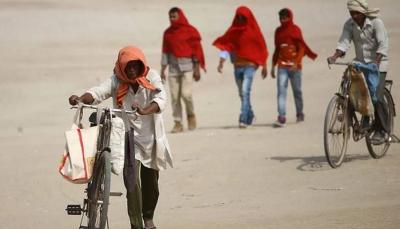Indian authorities announced that at least 15 people died yesterday, Thursday, due to suspected "heatstroke" in the states of Bihar and Odisha in the eastern part of the country, which is currently experiencing a severe heatwave expected to last until tomorrow, Saturday.
India is experiencing an extremely hot summer, with a region in the capital New Delhi recording the highest temperature ever in the country at 52.9 degrees Celsius this week, although this figure may be revised when the meteorological agency examines the sensors at the weather station that recorded it.
Despite forecasts of a drop in temperatures in northwestern and central India in the coming days, the current heatwave in the east of the country is likely to continue for two more days, according to the India Meteorological Department, which declares a heatwave when temperatures rise by 4.5 to 6.4 degrees Celsius above normal.
Shreekant Shastri, an official in the Aurangabad district, stated, "About seven other people died while on their way to the hospital yesterday, but the real cause of their deaths will be determined after autopsies."
The Odisha government has prohibited any outdoor activities for its employees between 11 a.m. and 3 p.m. when temperatures peak. Local media reported that three people died from suspected heatstroke in the neighboring state of Jharkhand.
In Delhi, the rise in temperatures caused birds and wild monkeys to faint or suffer from exhaustion. The city’s zoo relies on swimming pools and water sprays to provide relief for its 1,200 animals. Sangeet Kumar, the zoo's director, told Asia News International, "We have switched to a summer diet, which includes more fluids and all seasonal fruits and vegetables that contain more water."
Temperatures in Delhi are expected to reach 43 degrees Celsius today, and the city recorded its first heat-related death this week while facing severe water shortages.
Residents across Asia, including neighboring Pakistan, are suffering from rising temperatures, a trend scientists say is exacerbated by human-induced climate change.




